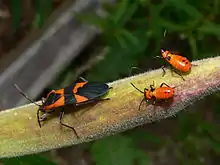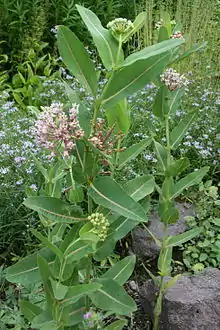Large milkweed bug
Oncopeltus fasciatus, known as the large milkweed bug, is a medium-sized hemipteran (true bug) of the family Lygaeidae.[2] It is distributed throughout North America. It ranges from Central America through Mexico and the Caribbean to southern areas in Canada.[2] Costa Rica represents this insect's southern limit.[3] It inhabits disturbed areas, roadsides and open pastures.[4] Due to this widespread geographic distribution, this insect exhibits varying life history trade-offs depending on the population location, including differences in wing length and other traits based on location.[5][6]
| Large milkweed bug | |
|---|---|
 | |
| Scientific classification | |
| Kingdom: | Animalia |
| Phylum: | Arthropoda |
| Class: | Insecta |
| Order: | Hemiptera |
| Family: | Lygaeidae |
| Genus: | Oncopeltus |
| Species: | O. fasciatus |
| Binomial name | |
| Oncopeltus fasciatus | |
Identification
Adults can range from 10–18 mm in length and have a red/orange and black X-shaped pattern on their wings underneath the triangle that is typical to hemipterans.[7] This feature makes the bug easily seen, acting as an aposematic warning to predators of distastefulness. O. fasciatus exhibits Müllerian mimicry and is noxious to predators. The ventral side of the fourth abdominal segment bears a black band in the male and two black spots in the female. Juveniles are born mostly red with black antennae and a few black spots, throughout growth the black spots are developed as well as wing pads. Eggs of this insect are bright orange and easily detectable.[8][9]
Life cycle

This large milkweed bug is a hemimetabolous insect, meaning it grows in stages called instars and goes through incomplete metamorphosis exhibiting small changes throughout development such as coloration changes, development of wings and genitalia. O. fasciatus begins as an egg and experiences four nymphal stages over 28–30 days before moulting to adulthood.[10] Females become sexually receptive within a few days of adulthood. Geographic location has a large effect on egg production rate and clutch size, although the intrinsic increase in reproduction depends on what the individual is acclimated to. For example, two close populations (60 km apart) residing on a sharp incline have differing optimal reproduction temperatures where the cooler (higher) adapted population is at 23 °C and the warmer (lower) population is adapted to 27 °C. Highest clutch size occurs in Puerto Rico, Florida and Texas populations at 30-50 eggs per clutch. Lowest clutch size was found in California at 25-30 eggs per clutch. Iowa and Maryland (northern populations) exhibited a clutch size in between the two extremes from 25-35 eggs per clutch.

In favourable conditions (tropics) reproduction occurs continuously all year round, in less-favourable conditions (temperate zones) reproduction occurs during the warmer months.[11] Reproducing when migrants arrive introduces gene flow between northern and southern populations, this provides an advantage to the mid-range populations (variable climates) because females then can ensure genetic variability. The milkweed bug can produce from one to three generations per year depending on climate and geographic location. O. fasciatus exhibits strong selection for survival and will halt reproduction as a trade-off if conditions are not ideal.

Diapause occurs on short days and on cold days in temperate regions and occasionally occurs during dry season in tropical regions. Most populations of the milkweed bug overwinter; usually after migration to their overwintering sites due to environmental triggers such as temperature and photoperiod.[12] However, photoperiod only predicts overwintering in areas where day length effects the maturation of milkweeds. Therefore, no overwintering occurs in tropical regions as it does not supply an adaptive advantage.
Migration

O. fasciatus can be separated into migrators and non-migrators. Palmer and Dingle[13] showed that northern populations such as the one in Iowa show the greatest tendency for long distance flight and are highly migratory. Oppositely, southern populations such as those in Puerto Rico show the lowest tendency and are sedentary.[14] South populations grow seasonally as migrants first appear in late spring and mid-summer.[15] A migratory syndrome has been described in the northern population, meaning that traits such as wing length, fecundity, developmental time and flight duration are all genetically correlated. Groeters and Dingle[16] suggested that selection is specific to the populations environment due to the small correlations between life history strategies across geographic ranges. A trade-off between migration and life history traits may be the causation of such a wide geological distribution. Attisano[17] suggested that genetic factors as well as environmental cues trigger migration in some individuals. Since long duration flights decrease with decreasing latitude, temperature is a strong factor influencing the migration. Also, this movement correlates with flowering of milkweeds which provides further evidence that environmental triggers relate to migration. Larger females are thought to allocate resources to migration simply because they have more to spare. Smaller individuals are thought to deploy alternative mechanisms; one being the reabsorption of oocytes for energy. The fact that these insects return to northern environments after migration could be the influence of a genetic predisposition or selected for due to crowding and increased intraspecific competition for resources in the southern areas.[18]
Tropical populations migrate shorter distances than temperate populations because spatial variation of their choice host is much greater, so it is advantageous to seek new plant congregations rather than tolerate the depletion of resources.
Diet
Oncopletus fasciatus is a specialist herbivore that frequently consumes common milkweed seeds, Asclepias syriaca Apocynaceae.[19] This bug also feeds on A. nivea, Sarcostemma clausa, Calotropis procera, and Nerium oleander. The southern populations often consume Asclepias curassavica, a tropical milkweed. When given sunflower seeds in a laboratory, this bug obtained 90% of their lipids, 50% of their protein and 20% of their carbohydrates, making it an efficient feeder. Toxic compounds in milkweeds are also sequestered, giving this insect its toxicity.
Adults wander during the daytime in search of food since milkweeds live in patches that can vary in size and distance apart from one another. When a follicle is found, they inject saliva into it through their long rostrums, this pre-digests the seed and allows O. fasciatus to suck it up through their anterior pump and pharynx. Often there are multiple individuals feeding on one follicle, suggesting that a signal is released by feeding individuals that indicates a good food source. It has been shown that adults are more likely to find a food source when another adult is already feeding on it, further supporting the signaling concept. Occasionally, females are seen feeding on shedding exoskeletons from moulting individuals. Rarely, cannibalization is observed in laboratory settings.[20]
Juvenile O. fasciatus require the seed of milkweed plants for development and growth. Adults can survive on other types of seeds such as: sunflower, watermelon, almond and cashew, as shown in lab populations. Nymphs live in large groups of about 20 individuals on the plant.[11] Juveniles have an advantageous discontinuous three-part gut that acts similarly to a crop, ventriculus and ileum however they are lacking definitive parts. During the final instar of development, oil accumulates to allow for more efficient absorption of nutrients as well as aid in osmoregulation.
Laboratory use
This insect is often used as a model organism and reared for laboratory experiments due to the insect being easy to rear and handle, short developmental time, few instars and a high fecundity.[21] The phylogenetic placement of O. fasciatus is ideal to use as an outgroup to make comparisons to more derived holometabolous insects, acting as a valuable organism for the study of evolutionary patterns.
References
- "Oncopeltus fasciatus". Integrated Taxonomic Information System.
- Attisano, A. (2013) Oosorption and migratory strategy of the milkweed bug,Oncopeltus fasciatus. Animal Behaviour 86(3):651-657.
- Baldiwn, D.J., Dingle, H. (1986) Geographic variation in the effects of temperature on life history traits in the large milkweed bug Oncopeltus fasciatus. Oecologia 69(1): 64-71.
- Dingle, H., Palmer, J.O., Leslie, J.F. (1986) Behaviour genetics of flexible life histories in milkweed bugs (Onceopeltus fasciatus). Evolutionary Genetics of Invertebrate Behavior. New York: Plenum Press.
- Dingle, Hugh; Evans, Kenneth E.; Palmer, James O. (1988). "Responses to Selection Among Life-History Traits in a Nonmigratory Population of Milkweed Bugs (oncopeltus Fasciatus)". Evolution. 42 (1): 79–92. doi:10.1111/j.1558-5646.1988.tb04109.x. ISSN 1558-5646.
- Palmer, James O.; Dingle, Hugh (1986). "Direct and Correlated Responses to Selection Among Life-History Traits in Milkweed Bugs (oncopeltus Fasciatus)". Evolution. 40 (4): 767–777. doi:10.1111/j.1558-5646.1986.tb00536.x. ISSN 1558-5646.
- Liu,P., Kaufman, T.C. (2009) Morphology and husbandry of the large milkweed bug, Oncopeltus fasciatus. Animal Behaviour 86(3): 651-657.
- "Milkweed bugs". www.missouribotanicalgarden.org. Retrieved 2020-08-04.
- "Large Milkweed Bug". www.insectidentification.org. Retrieved 2020-08-04.
- Leslie, J.F., (1990) Geographical and genetic structure of life history variation in milkweed bugs (Hemiptera:Lygaeidae: Oncopeltus). Evolution 44(2):295-304.
- Woodring, J., et al. (2007) Feeding, nutrient flow, and digestive enzyme release in the giant milkweed bug. Physiological Entomology 32:328-335.
- Dingle, H., et al. (1980) Variation in photoperiodic response within and among species of milkweed bugs (Oncepeltus). Evolution 34(2): 356-370.
- Palmer, J. O., Dingle, H. (1986) Direct and correlated responses to selection among life-history traits in milkweed bugs (Oncopeltus fasciatus). Evolution 40(4):767-777.
- Dingle, H., Evans,K.E., Palmer, J.O. (1988) Responses to selection among life-history traits in a nonmigratory population of milkweed bugs (Oncopeltus fasciatus). Evolution 42(1):79-92.
- Dingle, H., et al. (1980) Variation in photoperiodic response within and among species of milkweed bugs (Oncepeltus). Evolution 34(2):356-370.
- Groeters, F.R., Dingle, H. (1987) Genetic and maternal influences on life history plasticity in response to photoperiod by milkweed bugs (Oncopeltus fasciatus). The American Naturalist 129(3): 3332-346.
- Attisano, A. (2013) Oosorption and migratory strategy of the milkweed bug,Oncopeltus fasciatus. Animal Behaviour 86(3):651-657.
- Gonzalaz, M.S., et al. (2014) Effects of essential oil from leaves of eugenia sulcata on the development of agricultural pest insects. Brazilian Journal of Pharmacognosy 24(4):413-418.
- Woodring, J., et al. (2007) Feeding, nutrient flow, and digestive enzyme release in the giant milkweed bug. Physiological Entomology 32(4):328-335.
- Dingle, H., Palmer, J.O., Leslie, J.F. (1986) Behaviour genetics of flexible life histories in milkweed bugs (Onceopeltus fasciatus). Evolutionary Genetics of Invertebrate Behavior. New York: Plenum Press.
- Liu, P., Kaufman, T.C. (2009) Morphology and husbandry of the large milkweed bug, Oncopeltus fasciatus. Animal Behaviour 86(3): 651-657.
- Migratory behavior Roy L. Caldwell Mary Ann Rankin. Journal of comparative physiology. Separation of migratory from feeding and reproductive behavior in Oncopeltus fasciatus
| Wikimedia Commons has media related to Oncopeltus fasciatus. |

